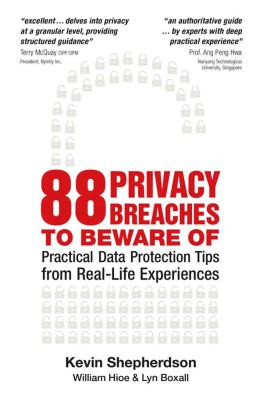Breached!

Oxford University Press is a department of the University of Oxford. It furthers the Universitys objective of excellence in research, scholarship, and education by publishing worldwide. Oxford is a registered trade mark of Oxford University Press in the UK and certain other countries.
Published in the United States of America by Oxford University Press
198 Madison Avenue, New York, NY 10016, United States of America.
Daniel J. Solove and Woodrow Hartzog 2022
All rights reserved. No part of this publication may be reproduced, stored in a retrieval system, or transmitted, in any form or by any means, without the prior permission in writing of Oxford University Press, or as expressly permitted by law, by license, or under terms agreed with the appropriate reproduction rights organization. Inquiries concerning reproduction outside the scope of the above should be sent to the Rights Department, Oxford University Press, at the address above.
You must not circulate this work in any other form and you must impose this same condition on any acquirer.
CIP data is on file at the Library of Congress
ISBN 9780190940553
eISBN 9780190940577
To Pamela and GriffinDJS
To Mom and DadWH
Table of Contents
Sometimes the thing we are looking for is right in front of us and yet we still dont see it. A great novella by Gabriel Garcia Marquez called Chronicle of a Death Foretold begins with the vicious fatal stabbing of the main character. The rest of the story reveals that all the warning signs about the murder were in plain sight yet ignored by everyone. The murder was readily preventablebut, because of human nature, it was almost inevitable.
The story of most data breaches follows the same pattern. We have read about thousands of data breaches, and the moral of most of these stories boils down to the same thing: The breaches were preventable, but people made blunders. What is quite remarkable about these stories is that they havent evolved that much in decades. The same mistakes keep happening again and again. After so many years, and so many laws to regulate data security, why havent the stories changed?
Let us begin with a classic data breach tale involving one of the largest and most notable breaches of its timethe Target breach of 2013. The story has many of the common themes of data breach stories, and what makes it particularly fascinating is that it is a sinister version of a David-and-Goliath story. Target was Goliath, and it was well-fortified. With its extensive resources and defenses, Target was far more protected than most organizations. Yet, it still failed. This fact should send shivers down our spines.
In mid-December 2013, right in the middle of the holiday shopping season, executives at Target found out some dreaded news: Target had been hacked. It was cruel irony that the second-largest discount store chain in the United States quite literally had a target sign on itTargets logo is a red and white bullseye. The hackers hit it with an arrow straight into the center.
Executives at Target learned about the breach from Department of Justice officials, who informed them that stolen data from Target was appearing online and that reports of fraudulent credit card charges were starting to pop up. Quite concerned, the Target executives immediately hired a forensics firm to investigate.
What they discovered was devastating. Targets computer system had been infected with malware, and there had been a data breach. It wasnt just a small breach, or a sizeable one, or even a big oneit was a breach of epic proportions.
Over the course of two weeks starting in November 2013, hackers had stolen detailed information for about 40 million credit and debit card accounts, as well as personal information on about 70 million Target customers. The hackers had begun to sell their tremendous data haul on black-market fraud websites.
The timing couldnt have been worse for Target. It suffered the single largest decline of holiday transactions since it first began reporting the statistic.
The pain was just beginning. On top of the lost profits, costs associated with the breach topped $200 million by mid-February 2014. These costs
What made this all the more unnerving for Target is that it had devoted quite a lot of time and resources to its information security. Target had more than 300 information security staff members. The company had maintained a large security operations center in Minneapolis, Minnesota, and had a team of security specialists in Bangalore that monitored its computer network 24/7. In May 2013just six months before the hackTarget had implemented expensive and sophisticated malware detection software from FireEye.
With all this securityan investment of millions of dollars, state-of-the-art security software, hundreds of security personnel, and round-the-clock monitoringhow did Target fail?
A common narrative told to the public is that this entire debacle could be traced to just one person who let the hackers slip in. In caper movies, the criminals often have an inside guy who leaves the doors open. But the person who let the hackers into Target wasnt even a Target employee and wasnt bent on mischief. The person worked for Fazio Mechanical, a Pennsylvania-based HVAC company, a third-party vendor hired by Target. The Fazio employee fell for a phishing trick and opened an attachment in a fraudulent email the hackers had sent to him. Hidden in the email attachment lurked the Citadel Trojan horsea malicious software program that took root in Fazios computers.
The Citadel Trojan horse was nothing novelit was a variant of a well-known malware package called ZeuS and is readily detectable by any major enterprise anti-virus software. But Fazio lacked the massive security infrastructure that Target had, allowing the malware to remain undetected on the Fazio computers. Through the Trojan horse, the hackers obtained Fazios log-in credentials for Targets system.
With access to Target, the hackers unleashed a different malware program, one they bought on the black market for just a few thousand dollars.
At first, the malware went undetected, and it began compiling millions of records during peak business hours. This data was being readied to be transferred to the hackers location in Eastern Europe. But very soon, FireEye flagged the malware and issued an alert. Targets security team in Bangalore noted the alert and notified the security center in Minneapolis. But the red light was ignored.
FireEye flagged as many as five different versions of the malware. The alerts even provided the addresses for the staging ground servers, and a gaffe by the hackers meant that the malware code contained usernames and passwords for these servers, meaning Target security could have logged on and seen the stolen data for themselves.
With FireEyes red lights blinking furiously, the hackers began moving the stolen data on December 2, 2013. The malware continued to exfiltrate data freely for almost two weeks. Law enforcement officials from the Department of Justice contacted Target about the breach on December 12, armed not only with reports of fraudulent credit card charges, but also actual stolen data recovered from the dump servers, which the hackers had neglected to wipe.
The aftermath of the breach caused tremendous financial damage to Target. It remains unknown what the precise cost of the breach was, but an estimate in Targets annual report of March 2016 put the figure at $291 million.











